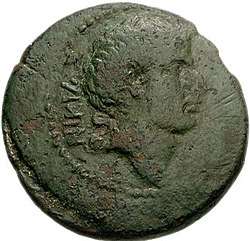Nikias of Kos
Nikias was a ruler of the island of Kos who died circa 20 BCE, labeled a tyrant. The Nazareth Inscription, once thought by some to be connected to Jesus, was likely proclaimed by Augustus in the wake of the descration of his tomb.[1]
Nikias of Kos | |
|---|---|
 | |
| Occupation | Ruler of Kos |
| Years active | c. 50 BCE to c. 20 BCE |
Coins created during Nikias's rule begin after the period 50 BCE.[2] The coins show a "young man with rather curly hair, broad forehead, hooked nose, some sparse chin hair, and a serious expression conveyed by his eyes and the downward line of his lips."[3][4] The style of the coins is possibly influenced by Augustus.[5]
Nikias is described by Strabo as a tyrant who was opposed by the "renowned harper" Theomnestus.[6]
Aelian reports in his Varia Historia that a Nicippus (apparently the same as Nikias) had a sheep that gave birth to a lion, which was a sign that he should be king.[7] This story is seen as a literary tradition that may point to Nikias coming from low birth.[8]
The epigrammatist Crinagoras of Mytilene wrote:[9]
Tell me not that death is the end of life.
The dead, like the living, have their own causes of suffering.
Look at the fate of Nicias of Cos.
He had gone to rest in Hades, and now his dead body has come again into the light of day.
For his fellow-citizens, forcing the bolts of his tomb, dragged out the poor hard-dying wretch to punishment.
References
- Gibbons, Ann (February 28, 2020). "Tablet thought to have guarded tombs after Jesus's death may not be what it seems". Science Magazine. Archived from the original on February 29, 2020. Retrieved February 29, 2020.
- Buraselis, Kostas (2000). Kos Between Hellenism and Rome. American Philosophical Society. p. 30. Retrieved 29 February 2020.
- Buraselis, Kostas (2000). Kos Between Hellenism and Rome. American Philosophical Society. p. 31. Retrieved 29 February 2020.
- "Coin of Kos with bust of Nikias". Museum of Fine Arts, Boston. Archived from the original on 29 February 2020. Retrieved 29 February 2020.
- "ISLANDS off CARIA, Kos. Nikias". Classical Numismatic Group. Archived from the original on 29 February 2020. Retrieved 29 February 2020.
- Strabo. "Geographica". p. Book XIV, Chapter 2. Retrieved 29 February 2020.
- Claudius Aelianus. "Varia Historia" (in Greek). Translated by Thomas Stanley. p. Book 1, Chapter 29.
- Buraselis, Kostas (2000). Kos Between Hellenism and Rome. American Philosophical Society. p. 38. Retrieved 29 February 2020.
- Crinagoras of Mytilene. "Epigrams". Translated by William Roger Paton. Archived from the original on 15 September 2019. Retrieved 29 February 2020.